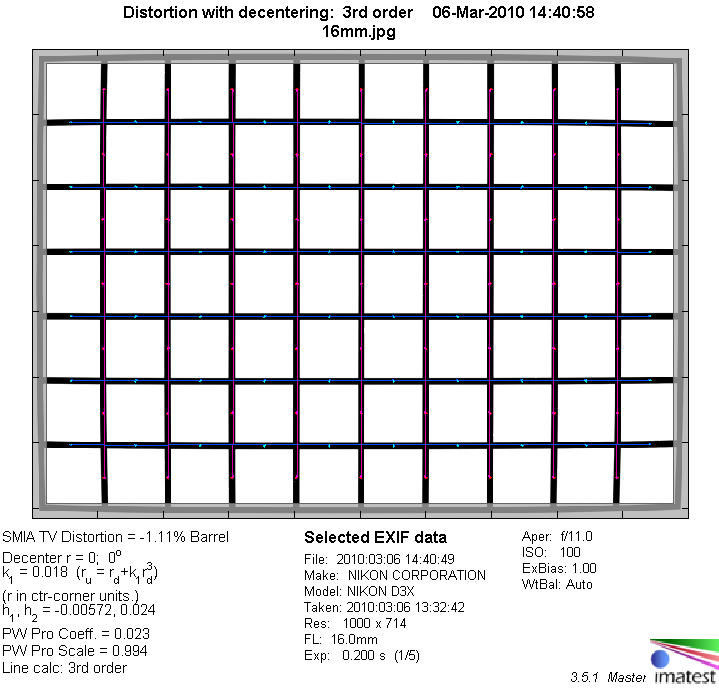|
Page 2 of 2

Distortion
In our FX review, the 16-35 VR showed a less than stellar distortion characteristic. It's typical for FX lenses to perform significantly better on smaller DX sensors in this regard, however the amount of improvement is surprising nonetheless.
At 16mm the lens shows barrel distortion of just above 1.1%. This can be visible in the field with certain subjects, but it's less than many other lenses in this focal range. At longer focal lengths, distortion switches over to the pincushion type, however it's low enough to not be really field-relevant.
|
Move the mouse cursor over the focal length text marks below to observe the respective distortion
|
| 16mm |
24mm |
35mm |
|

|
The chart above has a real-world size of about 120x80cm.
Vignetting
Vignetting is usually not a significant problem of FX lenses on DX cameras. This is especially true for lenses with rather moderate maximum aperture settings. So, with light fall-off values of below 0.5 EV, vignetting is no issue at all with this lens.

MTF (resolution)
The lens shows very good to excellent center sharpness at 16 and 24mm. The borders and corners follow closely behind here with good to very good sharpness.
At 35mm, resolution drops significantly in the image center as well as the borders and corners. Stopping down increases sharpness across the frame, however the center never reaches excellent resolution here and the extreme corners stay below very good figures.
Please note that the MTF results are not directly comparable across the different systems!
Below is a simplified summary of the formal findings. The chart shows line widths per picture height (LW/PH) which can be taken as a measure for sharpness.
If you want to know more about the MTF50 figures you may check out the corresponding Imatest Explanations

Chromatic Aberrations (CAs)
Chromatic aberrations (color shadows at harsh contrast transitions) are in the range of roughly 1.4 pixels at the image borders throughout most of the focal and aperture range, with slightly higher peak values at the shortest focal length wide open. At 35mm the amount of CAs is a bit lower, reaching just above a 1 pixel stopped down to f/11 and even less with larger aperture.
CAs can easily be corrected in software or by the camera itself (most modern Nikon DSLRs remove CAs themselves if you shoot JPGs).

Sample Shots
Full size sample images are available in our FX review of this lens.
VerdictOn our 16 MP DX test camera, the Nikkor AF-S 16-35 VR is a very good wide-angle to normal zoom lens that shows very good to excellent resolution in the center and very good border and corner sharpness at short and medium focal length settings. Only at 35mm the lens struggles on the high pixel density of the D7000's DX sensor. Distortion is well under control, the same is true for vignetting and chromatic aberrations. The build quality is excellent and in line with other professional Nikkor lenses. So, in summary, it's not an unattractive lens for DX shooters.
For DX only usage, however, it faces some serious competition by Nikon's own AF-S DX 16-85 VR lens. While the DX lens shows some more distortion and vignetting, it offers a lot larger focal range in a smaller package, better sharpness in the overlapping range and comes at a significantly lower price. In summary, the 16-85mm lens will probably be the more attractive lens for many.
However, for anyone living in both worlds, FX and DX, the 16-35 VR is a nice dual-use option, that serves quite well on both formats.
|